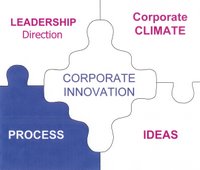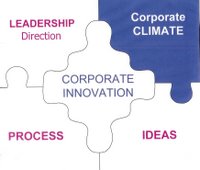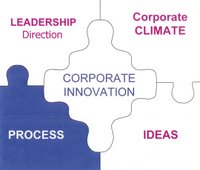
How to Be a Smart Innovator
Nicholas Carr talks about the right way to be creative -- and the wrong way WSJ, September 11, 2006; Page R7 I generally do not reproduce an entire article but this is fantastic. Mr. Carr describes how corporations should view innovation. This article illustrates our position that the goal of investing in innovation should lead to competitive separation (the outcome of competitive differentiation) at your target customers. I put this under the PROCESS category because it is my experience that the type of process you deploy will deal with the issues raised by Mr. Carr. I highlighted those areas I feel are most important. Enjoy!
Challenging the conventional wisdom seems to delight Nicholas Carr. Mr. Carr, 47 years old, also has turned a skeptical eye on another popular notion (he appears regularly in HBR) : If innovation is a good that companies should pursue, more innovation is even better, and the best innovations are those that upset existing markets or industries. Instead, Mr. Carr says, companies need to be prudent -- even conservative -- in where and how much they encourage innovation.
Wall Street Journal news editor Michael Totty and columnist Lee Gomes recently spoke with Mr. Carr about the best ways that companies can pursue novel thinking. Here are excerpts of that conversation.
The Price of Innovation
THE WALL STREET JOURNAL: What's wrong with unfettered innovation?
MR. CARR: American companies are in love with the idea of innovation, and that's great and it's necessary and it's one of the great strengths of businesses and American businesses in particular. But the danger is that companies can come to believe that innovation is a universal good and that they should be innovating everywhere in their company.
They lose sight of the fact that innovation isn't free, that innovation actually is quite expensive and quite risky. You need to bring the same kind of discipline to deciding where you innovate as you'd bring to any other kind of management question. You want to make sure that you innovate in those few areas where innovation can really pay off and create a competitive advantage and not innovate in other areas where it won't pay off.
WSJ: How does a company decide where and how to pursue innovation?
MR. CARR: You have to connect your innovation initiatives and your innovation investments to your broader business strategy, and look at those areas where you are going to get, or think you can get, a competitive advantage. For some companies, the highest potential areas for innovation may be in its manufacturing processes or in the way it manages its supply chain. For other companies, it may be in their products themselves. For still other companies, it could be in their branding and marketing areas.
Dell and Apple vs. Gateway
WSJ: Why did you start thinking or writing about this? Were there companies that you saw doing it badly, that evidenced an inappropriate enthusiasm for innovation?
MR. CARR: I'd seen -- particularly in a lot of business writings -- a kind of cult of innovation emerging that said innovation is an unalloyed good and you should be innovating everywhere in your company. And so that struck me as being too simplistic. One good example is if you look in the personal-computer industry at Dell and Apple. Dell's having some problems now, but it's still the most profitable PC maker and has been for some time. Apple is doing very well with a different strategy. You look at those two companies and you see that Dell has been very aggressive as an innovator in its basic processes, and particularly [in] finding ways to reduce costs as low as possible. But it hasn't been an innovator in the product itself. It's in fact very much gone the commodity route, which up until now was a very powerful strategy for it.
Apple is almost the mirror image of Dell in that it has been very good at copying the process side [by] looking at what companies like Dell have been doing, and then being a very aggressive innovator on the product side, trying to get distinctive products out there. Both have been successful by being very focused in the way they innovate.
A company like Gateway tried to do both. It tried to innovate in its products and get differentiated products, and it also tried to innovate in its processes. It even tried to innovate in its retailing strategy and tried to roll out a bunch of services as well. By innovating so broadly it didn't actually create any competitive advantage and ultimately struggled enormously and fell behind those more disciplined innovators.
Another of the dangers of the cult of innovation is the belief that you need to go for home runs in innovation and that you need to be a leader in figuring out the innovations that are going to be disruptive of your entire industry.
When you look at the type of innovations that pay off, they are often much more modest innovations that, instead of causing disruptions, mend those disruptions or help regular customers adapt to new technologies or new innovations.
Building Bridges
WSJ: In that context, you have written about "bridging" technologies. Explain what you mean by that.
MR. CARR: For a lot of companies, the people who are in charge of innovation, whether it's the R&D folks or product developers or entrepreneurs in small companies, are the people who are the most passionate about the particular new technologies. They tend to be the early adopters, and that can give them a distorted view of the market. Because most normal people are actually quite conservative: They'll adopt a new technology, but they tend to do it quite slowly. That opens up a big opportunity for companies that are smart in figuring out how to help normal, everyday customers create a bridge between an old, established technology or way of doing things and a new one.
New technologies tend to be difficult to use. They tend to be buggy and not work perfectly. They tend to be expensive. All of those things mean that they tend to be limited to a small, early-adopter customer base for quite a long time. If you can figure out a way to move with the market toward the new technology, I think you can do a lot better than jumping ahead.
Back in the dot-com era in the late 1990s, you had all sorts of new-media companies being organized to try to deliver video online. And almost all of them went bust for a very simple reason: Very few U.S. consumers actually had broadband access. The companies were way out ahead of the market in innovation. Even today, fewer than half of American households have broadband Internet access.
In contrast, you have a company like Netflix that was able to bridge between the new technology -- the Internet -- and the old technology, which is the delivery of video in physical form, by using the U.S. mail to deliver DVDs, yet having a very sophisticated ordering system online that didn't require broadband access to use.
WSJ: Is it ever better to be the first mover?
MR. CARR: The studies that I've seen indicate that it's rarely the very first mover into a market who ends up winning that market. Today we think of the iPod as being an enormous innovation, and in one way it was. But in fact, when the iPod came along there were already MP3 players and there were already lots of digital jukeboxes.
WSJ: Managed innovation seems really difficult to pull off. You manage it too tightly and you squelch it, or you let it go too far and it runs amok. How does a company create a balance so that people are coming up with new ideas but they're not tearing apart the company?
MR. CARR: You can manage where you innovate and pick and choose your targets. But once you've chosen your targets, trying to micromanage the actual innovation process can backfire by undermining the creativity of your best people.
My argument isn't that you should try to impose overly formal rules and regulations and practices on your innovators or on your innovation teams. It's just that you should make sure that those teams and those people are focused on the right areas of your business that require innovation.
That's not always the product. It's not always something that the customer sees. It might be in a very nitty-gritty process, even back-office processing if that's where you're going to have the most opportunity to distinguish yourself from the competition. The greatest innovations aren't necessarily the ones that translate into superior products. Equally powerful are innovations that let you reduce your costs. Just because an innovation isn't visible to your customers doesn't mean that it can't be extremely powerful for your company.
One other thing that I think is important. Very strong innovation can translate into a message to an organization that being a copycat or an imitator is bad. If you look in most companies -- even very successful ones -- in most areas of their business they're actually very effective copycats or imitators. They're looking for the best practices that are out there among their competitors and other companies, and they're copying them in getting their processes and components to the best possible level and then innovating in more focused ways. The ability to be a good copycat is extremely important for companies and probably as important as being a good innovator.
The second organizational danger of pushing everybody to innovate, and of sending out a message -- as a lot of companies do -- that we need to innovate everywhere, is that you begin to devalue competence among your staff. There are some people who are not going to be good innovators but might be extremely competent in what they do. It's important that those people feel valued in that they're rewarded for their competence.
Creative people are great, but creativity tends to be a messy process. There are going to be areas of your business where that's OK, and there are going to be areas where the last thing you want is messiness. In those areas you should value and reward competent people who can do routine tasks very, very well. That's just as important as having brilliant, breakthrough thinkers.





